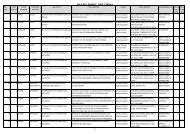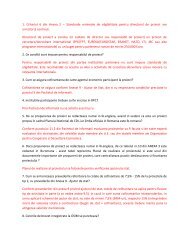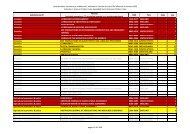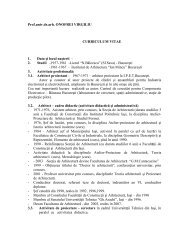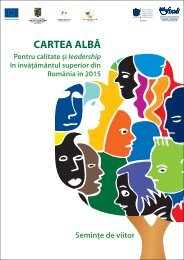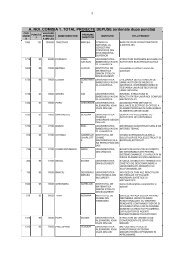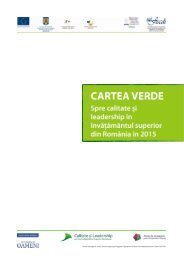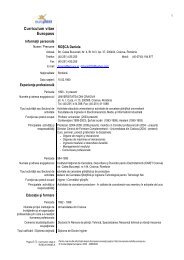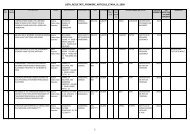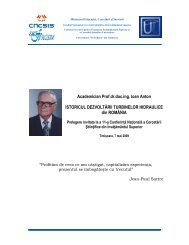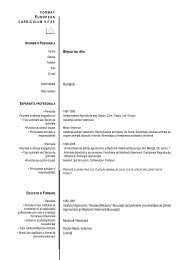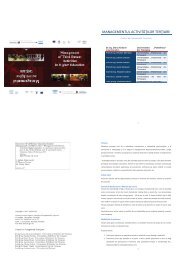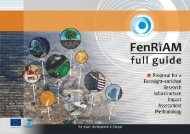Povesti de succes - uefiscdi
Povesti de succes - uefiscdi
Povesti de succes - uefiscdi
Create successful ePaper yourself
Turn your PDF publications into a flip-book with our unique Google optimized e-Paper software.
Centrul <strong>de</strong> Chirurgie Generala şi Transplant Hepatic<br />
60<br />
publicarea in 2009 în Cancer Gene Therapy a articolului: Transcriptional<br />
silencing of ETS-1 efficiently suppresses angiogenesis<br />
of pancreatic cancer, în care s-a <strong>de</strong>monstrat că transferul<br />
unei molecule dominant negative a ETS-1 (ETS-DN) în linii<br />
celulare tumorale pancreatice nu a afectat rată <strong>de</strong> proliferare în<br />
vitro, dar a inhibat semnificativ creşterea lor in vivo pe mo<strong>de</strong>lul<br />
<strong>de</strong> şoarece imuno<strong>de</strong>ficient.<br />
În cadrul proiectulu CEEX 64 /2006 (cu o valoare <strong>de</strong> finanțare<br />
pentru CCGTH <strong>de</strong> 450 000 RON) am studiat, împrenă<br />
cu partenerii <strong>de</strong> la Institutul National <strong>de</strong> Crecetare- Dezvoltare<br />
în Domeniul Patologiei Științelor Biomedicale “Victor Babeș”,<br />
dr Cristina Tănase, expresia cav 1 la 34 <strong>de</strong> pacienți cu a<strong>de</strong>nocarcinomă<br />
pancreatic și în țesutul peritumoral asociat prin<br />
meto<strong>de</strong> <strong>de</strong> imunohistochimie și western blot. Am corelat expresia<br />
Cav-1 cu cea a altor markeri tisulari tumorali: Ki-67,<br />
p53), dar și cu a markerilor serici CA19-9. În țesutul tumoral,<br />
atât celulele tumorale cât și cele din vase exprima cav-1, iar în<br />
țesutul peritumoral expresia cav-1 există doar în vase și doar<br />
ocazional se exprimă în celule ductale sau parenchimale. Supraexprimarea<br />
cav-1 a fost asociată cu dimensiunea tumorală, stadializare,<br />
iar expresia cav-1 în țesutul tumoral s-a corelat cu<br />
creșterea nivelului seric pentru CA 19-9.<br />
- medicină regenerativă: terapii celulare<br />
Terapia celulară cu celule stem și cu celule progenitoare<br />
hepatice reprezintă o abordare nouă, promițătoare în regenerarea<br />
hepatică. Celulele stem hematopoietice adulte, obținute<br />
din sângele periferic, sau din măduva osoasă pot reprezenta un<br />
avantaj consi<strong>de</strong>rabil în folosirea lor pentru terapia leziunilor hepatice<br />
prin faptul că ele pot fi prelevate <strong>de</strong> la donori vii,<br />
printr-o tehnică minim invazivă. Teme <strong>de</strong> cercetare abordate în<br />
cadrul acestui domeniu au potențialul, prin rezultatele scontate,<br />
<strong>de</strong> a aprofunda cunoașterea în domeniul biologiei celulare hepatice,<br />
constituind o sursă importantă <strong>de</strong> date pentru viitoarele<br />
studii clinice. Celulele stem adulte pot fi manipulate in vitro<br />
pentru a induce diferențierea în celule hepatocyte like. Impreună<br />
cu partenerii proiectului CEEX 65/2006 (cu o valoare <strong>de</strong><br />
finanțare pentru CCGTH <strong>de</strong> 640 000 Ron) <strong>de</strong> la Institutul <strong>de</strong><br />
Virusologie “Ștefan S. Nicolau” și <strong>de</strong> la Institutul Național <strong>de</strong><br />
Crecetare - Dezvoltare în Domeniul Patologiei Științelor Biomedicale<br />
“Victor Babeș” s-a propus să se <strong>de</strong>termine diferențierea<br />
celulelor stem mezenchimale umane în hepatocite,<br />
folosind factori “specifici hepatici”: hepatocyte growth factor,<br />
Insulin-Transferrin-Selenium, <strong>de</strong>xamethasone, nicotinami<strong>de</strong>.<br />
Celulele stem mezenchimale umane au fost expuse la diferite<br />
medii <strong>de</strong> cultură în care acești compuși au fost folosiți individual<br />
sau în diferite combinații. Diferențierea hepatocitara a fost<br />
<strong>de</strong>terminată prin tehnici <strong>de</strong> RT- PCR, imunohistochimie, teste<br />
funcționale. Profilul expresiei genice pentru: albumin, alphafetoprotein<br />
și cytokeratin 19 a arătat că atunci când acești factori<br />
sunt folosiți individual se obține o diferențiere hepatocitară<br />
incompletă. Folosirea unui mediu <strong>de</strong> cultură care să contină toți<br />
factorii enumerați a arătat o expresie crescută pentru albumină,<br />
dar nu și pentru cytokeratin 19. Celulele obținute prezintă<br />
funcții hepatice specifice, incluzând producerea <strong>de</strong> uree, glucoză.<br />
Rezultatele obținute vor fi prezentate la 10 th International<br />
Cell Transplant Society (CTS) Congress in Okayama, Japan,<br />
care se va <strong>de</strong>sfățura între 20-21 Aprilie 2009.<br />
În CCGTH s-au efectuat în premieră națională primele autotransplante<br />
<strong>de</strong> celule stem adule pentru afecțiuni hepatice și<br />
pentru diabet, primul transplant combinat <strong>de</strong> insule pancreatice<br />
și ficat. Cazul <strong>de</strong> autotransplant <strong>de</strong> celule stem la un caz cu<br />
transplant hepatic domino a fost publicat în Clinical Transplantation.<br />
În CCGTH s-a realizat testarea pe mo<strong>de</strong>l animal a unei<br />
combinații constituie dintr-o matrice biologica și celule stem<br />
mezenchimale (CSM) din maduva osoasă, urmârind regenerarea<br />
in vivo a peretelui digestiv. S-au folosit ca și suport vase<br />
<strong>de</strong> porc <strong>de</strong>celularizate, acoperite <strong>de</strong> un burete <strong>de</strong> collagenagarose<br />
combinat cu CSM, urmârind a obține un patch 3D cu<br />
următoarele proprietăți: biocompatibil, bio<strong>de</strong>gradabil, porozitate<br />
a<strong>de</strong>cvată, integritate structurală. Rezultatele noastre arată<br />
că patchul 3D imbogățit cu CSM promovează repararea <strong>de</strong>fectului<br />
peretelui digestiv cu reconstitirea structurii acestuia. CSM<br />
au dus la îmbunătățtirea grefării patchului 3D și regenerarea<br />
tisulară completă fără a fi necesară realizarea imunosupresiei<br />
recipientului. Rezultatele cercetărilor s-au concretizat în lu-<br />
angiogenesis of pancreatic cancer”, which <strong>de</strong>monstrated that the<br />
transfer of a dominant negative molecule ETS-1 (ETS-DN) in<br />
pancreatic tumor cell lines did not affect the rate of proliferation<br />
in vitro, but significantly inhibited their growth in vivo on<br />
mouse mo<strong>de</strong>l of immuno<strong>de</strong>ficiency.<br />
In the project CEEX 64 / 2006 (with a funding value of 450<br />
000 USD for CGSLT) we studied with the National Institute of<br />
Development Field in Biomedical Science Pathology "Victor<br />
Babes",(Dr Cristina Tanase)the expression of CAV 1 in 34 patients<br />
with pancreatic a<strong>de</strong>nocarcinoma and peritumoral tissue<br />
trough Immunohistochemistry and western blot. We correlated<br />
the expression of Cav-1 with other tissue tumor markers: Ki-67,<br />
p53), but also with serum markers CA19-9. In tumoral tissue,<br />
both tumor cells and the vessels express CAV-1, and in peritumoral<br />
tissue expression of CAV-1 exists only in vessels and only<br />
occasionally is expressed in cells or ductile parenchyma. Superexpressing<br />
of CAV-1 was associated with tumor size, staging,<br />
and CAV-1 expression in tumoral tissue was correlated with increased<br />
CA 19-9 serum level.<br />
- Regenerative medicine: cells theraphy<br />
Consi<strong>de</strong>ring recent findings stem cells could be harvested<br />
from a patient and used to repair his own damaged liver. The<br />
adult hematopoietic stem cells can be harvested by a minim invasive<br />
technique from the peripheric blood, bone marrow and<br />
used in liver diseases. Additionally, stem cells may be manipulated<br />
in vitro, to induce hepatic differentiation. The research activities<br />
of CCGTH and the project partners (Romanian Institute<br />
of Virology and „ Victor Babes” National Institute of the CEEX<br />
65/2006 project) ( total budget of CCGTH is 640000 Ron) aims<br />
to <strong>de</strong>termine the differentiation efficacy of various liver-specific<br />
factors (hepatocyte growth factor, Insulin-Transferrin-<br />
Selenium, <strong>de</strong>xamethasone, nicotinami<strong>de</strong>) used for stem cells differentiation<br />
into hepatocyte-like cells. Human mesenchymal<br />
stem cells were exposed to different media containing these<br />
compounds ad<strong>de</strong>d individually or in various combinations. Hepatic<br />
differentiation was assessed by quantitative RT-PCR, and<br />
immunocytochemical staining for stemness or liver-specific<br />
genes and proteins like: albumin, cytokeratins 18, 19, HepPar-<br />
1, alpha-fetoprotein and nestin, and also by some functional<br />
tests. The expression profiles of albumin, alpha-fetoprotein and<br />
cytokeratin 19 <strong>de</strong>monstrated that when hepatocyte growth factor,<br />
nicotinami<strong>de</strong> or <strong>de</strong>xamethasone were ad<strong>de</strong>d individually an<br />
incomplete hepatocyte differentiation was achieved and the obtained<br />
cell populations contained bivalent progenitors that express<br />
both hepatic (albumin) and biliary (cytokeratin 19)<br />
markers, together with alpha-fetoprotein. When all factors were<br />
ad<strong>de</strong>d in culture cells become more committed to hepatic lineage,<br />
showing an increased expression of albumin but not cytokeratin<br />
19. The obtained cells presented specific hepatic<br />
functions, including glycogen storage, urea and glucose production.<br />
The results shows that each of the liver-specific factor<br />
tested individually. The perliminary results will be presented at<br />
the la 10th International Cell Transplant Society (CTS) Congress<br />
in Okayama, Japan, in April 2009.<br />
There have been also performed the first autotransplantations<br />
with adult stem cells for liver diseases and diabetes mellitus,<br />
the first combined liver-islet cell transplantation. The case<br />
of stem cell autotransplantation in a liver transplanted patient<br />
has been published in Clinical Transplantation.<br />
- In the CGSLT it has been performed on the animal mo<strong>de</strong>l a<br />
combination of a biological matrix and mesenchymal stem cells<br />
(MSC) from bone marrow, following in vivo regeneration of digestive<br />
wall. There were used as support <strong>de</strong>cellarized pig vessels<br />
covered by a collagen-agarose sponge combined with MSC,<br />
aiming to obtain a 3D patch with the following properties: biocompatible,<br />
bio<strong>de</strong>gradable, a<strong>de</strong>quate porosity,and structural integrity.<br />
Our results showed that 3D MSC-enriched patch<br />
promoted the <strong>de</strong>fect repair of the digestive wall. The MSC led<br />
to improvement 3D patch grafting and complete regeneration of<br />
the tissue without the need of adding immunosuppression. The<br />
results of this research were published in this paper: Transplantation<br />
of mesenchymal stem cells cultured on biomatrix support<br />
induces digestive tract of repairing iatrogenic <strong>de</strong>fects. Mirela-<br />
Patricia-BOETI Sirbu, M. Chivu, Liliana L. Pâslaru, C.<br />
Efrimescu, V. Herlea, C. Pecheanu, L. Moldovan, L. Dragomir,<br />
C. Bleotu, E. Ciucur, C. Vidulescu, M. Vasilescu, A. Boicea, S.<br />
Mãnoiu, MI Ionescu, I. Popescu (surgery, 104 (1): 55-65)



